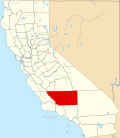Founding and development
Pine Mountain Club was developed in 1971 by Tenneco. [5] The first announcement was made from Houston, Texas, in April of that year when the company said it would develop "more than 1.1 million acres of land in Arizona and Southern California." [6] [7] Tenneco was the Bakersfield-based western land-development arm of Tenneco, Inc., of Houston. [8]
About half that acreage was to be in Kern County, where the projects would include the residential development of 6,500 acres surrounding the then-new California State College near Bakersfield and 3,200 acres in the Los Padres National Forest, also mostly for residences (Pine Mountain Club). [6] [7]
The forest project was to set aside a thousand acres for vacation home sites and 2,200 acres "for permanent preservation in their natural state." The program was to be directed by John E. Sommerhalder, president of Tenneco West. [6] [7] [9] The land was part of a 3,200-acre tract of pine forest and meadowland, formerly a private preserve. [10]
Tenneco West was a Bakersfield subsidiary that administered all the western holdings of Tenneco, "the parent, Houston-based, multi-industry company." [11]
Adjacent to the clubhouse will be a nine-hole executive golf course[,] and other recreational facilities are a heated swimming pool, archery range, volleyball and basketball courts, a lake stocked with fish and a community barbecue area. [11]
Tenneco West President Sommerhalder said the club was believed to be among the largest all-electric family recreational resorts in California. Three kinds of "vacation or weekend homesites" were to be offered: (1) One- to three-bedroom dwellings, (2) modular homes, and (3) space for mobile homes. [11]
Hiking trails, bridle trails (16 miles marked for from one-hour to all-day rides), an equestrian center with 10-stall barn, tack room, riding ring and corrals for boarding horses also will be available. . . . Later this year, a general store and laundromat will be added. [11]
The prices were estimated to begin from about $13,500 for a one-bedroom house and lot. [9]
At the time of the announcement in 1971, "four deep wells" had already been sunk and an "extensive network of reservoirs and pipelines" laid, with a filtration plant near the commercial center. [9]
Sommerhalder said the developer had the "assistance of Simon Eisner, nationally known environmental planner." [11]
Eight months after the opening, seventy-nine percent of the 1,309 purchasers indicated in a survey that construction of a vacation home was the prime reason for buying a lot and 43% of that group said they intended to start building during 1972. [12]
The development's sixth and final section, on a plateau some thousand feet higher than the clubhouse, went on sale in March 1973. [13]
Mil Potrero Highway
Tenneco West improved a "winding, steep, one-lane dirt road" called Mil Potrero west from Pine Mountain Club to California State Highway 33 into a "comfortable, convenient and safe way . . . to view what is generally regarded as Southern California's most strikingly beautiful scene." The cost for the 6.5-mile segment was estimated at nearly a million dollars. John E. Sommerhalder, the company president, said the road opened up "a large segment of the [Los Padres National] forest that, until now, has been almost inaccessible." [14]
The job was unusually difficult, partly because of the mountainous terrain and partly because of protective and restorative measures taken to reduce to a minimum the disturbance to the natural surroundings. . . . The project had to conform to the specifications and requirements of both Kern County and the U.S. Forest Service. In effect, it is already a public road, although Tenneco must maintain it for a year before the formal dedication as a public road can take place. [14]
To keep damages to the forest at a minimum, contractors Yeager Construction of Riverside and Desert Construction of Victorville were required to do all the work from the existing right-of-way and forbidden to build a temporary construction road alongside. Fire-protection equipment had to be on hand at all times. [15]











